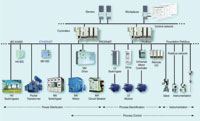
Posted to News on 20th Oct 2010, 00:00
Standardising on a single communications protocol
Things have come a long way since the costly master/ slave applications of Modbus and RS232. Colin Pearson of ABB discusses developments in Industrial Ethernet.

There are many factors driving suppliers of automation systems, vendors and third party suppliers, to minimise the number of different protocols used throughout their systems. The primary driver is cost. The cost to develop and maintain several product ranges with multiple protocols can stifle development and make systems more expensive than necessary. Then there is the risk to project schedules, and further cost, in interfacing equipment from different suppliers using different protocols. It can hit a project at the worst possible time, when the implications of delays are critical to start up and where getting expertise is difficult and costly. This can lead to delays and, depending on the contractual makeup, can also lead to several non-technical issues holding up progress.
Industrial Ethernet has proven itself to have the flexibility and robustness to cover almost all automation topology requirements. Relatively cheap and simple 'off-the-shelf' technology can be used to route standard Ethernet networks through hazardous areas, convert to wireless and transmit long distances whilst maintaining a common switching platform. With these standard switches it is possible to take advantage of V-LAN features thus simplifying the network layouts. As the standard technology currently provides a backbone in the region of 1Gbps the available bandwidth is huge. This is why the more modern systems are able to fully integrate telecoms and electrical assets with their automation systems without experiencing network traffic issues.
Some of the more modern automation systems link the IT infrastructure to the integrated alarm and asset management systems and as such when faults are detected on any IT asset, including network switches and PC's, the system users are immediately informed and can react accordingly.
Another major advantage with standardising on Ethernet is the availability of the various timing protocols associated with Ethernet. As the major automation suppliers are now integrating electrical and telecoms systems, the common network architecture ensures that any 'Time Synchronisation' signals (SNTP/CNCP), whether locally generated or provided by GPS systems can be supplied to all Ethernet connected components. This can provide significant advantages when reviewing alarm/ event sequence of events or audit lists, whereby entries can be accurate to the millisecond. One of the recent advances of automation systems is the inclusion of IEC61850 and Profinet over Ethernet. Companies like ABB and Siemens can provide IEC61850 interface cards which bridges the link between previously disparate domains of electrical and automation. Having such interfaces removes the requirement for all the costly hard-wired inter-system cabling required in the past.
Data transfer
Generally, with such systems, data is passed vertically to the HMI layer via an IEC61850 OPC server (connected via standard Ethernet technology) and load-shed commands are issues horizontally via a prioritised network protocol (GOOSE). These load-shed commands can execute quicker on the Ethernet network than they could have, had they been hard wired to the relays themselves. This means that the automation vendor's controllers and tools can be used to implement Power Management Systems (PMS) rather than having to implement expensive wiring, engineering and interface management with third parties.
With the inclusion of Foundation Fieldbus, another opportunity arose which allowed the use of Ethernet, rather than connect H1 segments directly to controllers and suffering simple Ohms Law issues thus reducing the number of device per segment on long run cables. One automation vendor has taken Ethernet further and implemented its Foundation Fieldbus solution on a High Speed Ethernet ring. The advantage of this solution is that the Ohms Law limitations do not apply therefore users are able to better manage the number of devices per segment. This solution also offers a very high level of flexibility due to the fact that the Ethernet ring can be easily passed through hazardous areas without complex and costly hardware. It is easy to see how this High Speed Ethernet ring could be easily utilised for the next generation of Ethernet instrumentation and the online buzz for such devices is just beginning to build pace.
A recent ARC report highlights the migration of Ethernet to field device level and describes the mindset change which will eventually lead to one common architecture from top to bottom making systems more efficient, easier to configure and maintain whilst ensuring the end users are not faced with long term obsolescence issues.
The topologies of tomorrow do not stop at the automation layer anymore. Forward thinking EPC's and end-users are looking to extend the real-time data all the way to the Enterprise Layer as it is in this domain where the real cost and productions savings are made. Business decisions in the more modern systems can have a direct and immediate impact on the plant or production operations. Likewise, where automation systems are directly connected to fiscal systems, such as gas storage projects, which buy or sell gas as the market demand warrants, these system now have access to real-time data to not only aid them in making their decisions but it is now also possible to recognise when production rates can be increased or decreased. With integrated asset systems, electrical integration (performing load-shedding or peak-shaving functions) and direct links via Ethernet then efficiency is guaranteed.
It is not only automation systems that have jumped on the Ethernet train, previously disparate systems such as computerised maintenance packages, such as SAP and Maximo, Information Management systems such as OPI PI and IP21, simulation model manufacturers such as RSI have all invested in providing modern efficient data transfer systems utilising Ethernet. Utilising OPC now ensures all the systems can be connected and information transmitted with the minimum of risk.
ABB Automation Technologies (Instrumentation & Automation)
Howard Road
Eaton Socon
PE19 8EU
UNITED KINGDOM
+44 (0)1480 475 321








